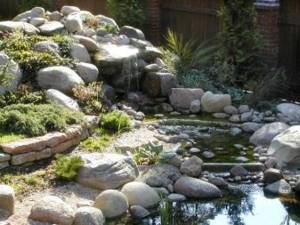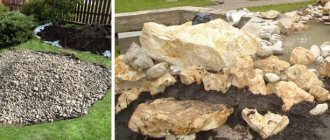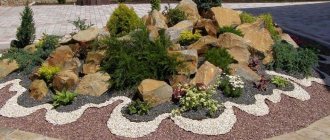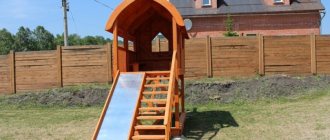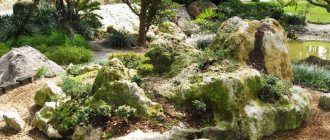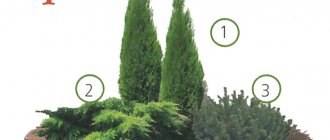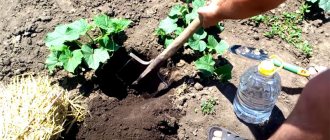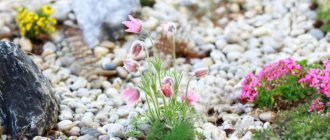Alpine slide made of stones in the garden
The Alpine slide has many styles and design options. The best location is a small slope. It can be lined with stones, and low-growing plants typical of mountains can be planted between them. A slope running along the terrace or near the edge of the site can serve as the basis for a rock garden.
When a rocky garden is created, unevenness and elevations always form. In addition to placing large stones, crushed stone is added to the soil.
It is recommended to add coarse sand to clay soil. This is necessary to create favorable conditions for plants.
In order for the alpine hill to bloom profusely and be clearly visible, you need to place it in an open place where there is enough sunlight . Some mountain plants are able to live in a poorly lit space, for example near a house or fence, but they should also be illuminated by the sun at least several hours a day.
If you plan to place the rock garden in the shade of trees, then the choice of plants will be greatly limited, since after rain the water under the crown will dry out very slowly. In this case, you need to install massive stone blocks and plant ferns such as ostrich and kostenz.
Do-it-yourself rock garden at the dacha. You will read about this in our next article. And from this article you will learn what trellises for grapes are and how to make them.
Interesting landscape design options
Park areas are rarely complete without the dazzling beauty of a rock garden or rock garden. It’s no wonder that many people want to have such beauty before their eyes all the time. It is unlikely that anything could be fresher, more beautiful and charming than such a composition on a personal plot.
Below are interesting examples of rock gardens and rock gardens for inspiration, because work on each site will require a unique project.
An example of a classic rockery in the Japanese style. A minimum of plants among the lifeless stone landscape.
A rock garden staircase formed from flat rocks.
An inspiring example of a rock garden with a waterfall.
Alpine hill with coniferous bushes and a decorative mound of multi-colored gravel.
A portable mini-rock garden in a concrete flowerbed, cast by hand. The plant part of the composition consists of succulents.
Miniature copy of a mountain landscape.
Rock garden-lawn during flowering period.
An option for using ceramic products to disguise the water supply pipe. Fern, as a moisture-loving plant, pleases its owners with lush greenery.
A breathtaking rockery with ground cover plants.
Mini pond made from a car tire.
See the next video for more details.
Formation of drainage
- The top layer of soil must be removed; it usually takes about half a meter.
- Laying a layer of gravel or broken brick will ensure that water quickly drains away from the plant roots.
- Crushed stone or gravel is added to the garden soil, mixed with it in a 3:1 ratio. If the soil is clayey and also heavy, you need to additionally mix in coarse sand.
- Aesthetic stones should be placed on the surface in a free arrangement, as the composition should look natural. The stones are laid one third underground with the flat side.
- When choosing stones, you should not mix several types, for example, solid boulders together with fragments of granite. Depending on the color of the stone, you can select plants. If they create a dark background, plantings with green foliage with a silver sheen are perfect. A light background allows you to use dark, rich colors of leaves or their burgundy tint. If you manage to choose a harmonious combination of smaller stones with massive ones, the site will resemble a highland landscape.
- Plants grow in the spaces between the stones. If those varieties are selected that deteriorate from waterlogging, a layer of gravel is poured onto the bottom of the dug hole before planting for drainage.
Rock garden flowers, or following logic and impeccable taste
So, an alpine slide in your garden is a miniature of the Alps and their lawns. Where have you seen large trees and dense plantings in alpine landscapes? That's right, we didn't see it, because the decoration of the gentle slopes of the Alps are creeping plants, mosses and lichens, ground cover or bright flowers of small height, dwarfs.
Therefore, if your site allows it, and you want to recreate on it a piece of a birch grove, a mixed forest, and an impenetrable spruce forest in the Russian style, do it on the periphery of the site, and leave the central part for the alpine hill so that it shines on its territory during in all its glory. In this case, select the following plants for her:
- ground cover: mosses, sedums, lichens. They can decorate any tier of the slide, but it is worth remembering that they can get “lost” among other plants. Leave for them a certain zone, which from early spring until the last days of autumn will be expressed in emerald greenery, gray velvet, frost and other interesting shades (rock alyssum, Caucasian moss, gray fescue, felt grass);
- young of various shapes and colors. They will delight you with the splendor of their buds and the shades at the ends of the petals, and in mid-summer - with interesting thick stems-inflorescences;
- perennial flowers of dwarf species. Phlox, decorative violets, daffodils and even tulips are appropriate here;
- annual flowers. Petunia and gazania, salvia and ranunculus, tagetis and Chernobrivets will create the mood in the rock garden, becoming bright inclusions that can slightly “blur” green and dove, light green and chocolate, and other other colors.
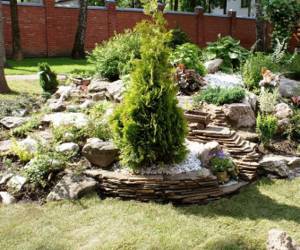
In addition, their height will play a significant role in choosing plants for the next season. Inspecting the composition, noticing the details, you will see that, for example, the hosta was planted very high and shades the saxifrage, and the low-growing thyme has grown together with the aubrieta and became a single purple background at the time of flowering. And there are dozens of such examples. Therefore, to create a harmonious alpine slide, which will ideally combine colors, shades and halftones of burgundy and red, orange and lemon, olive and terracotta, you need to draw a small sketch with the names of the planted plants. By changing one flower to another over a couple of seasons, observing them, you will soon fill the entire rock garden with your favorite flowers and greenery, which form a harmonious beginning, a focal point for unifying the style.
Rock garden of conifers
Spruce is best suited for rock gardens. Caring for it is not difficult, and the choice between types is great. For alpine hills created in the middle zone, the most suitable are considered to be common spruce, Serbian, Canadian, and prickly. They are quite hardy and resistant to frost. It should be planted in open areas; it is not advisable to place it in the shade. During drought or excessive soil moisture, these plantings usually do not become diseased.
Please note that Canadian spruce should not be in bright sun, as it may burn a little.
Pine is a fairly popular tree. Scots pine is usually used for rock gardens. You don't have to spend a lot of time caring for this plant. Depending on the overall design, low pine, mountain pine or wanderer cedar are used. Mountain pine is usually a large plant, but some varieties are strikingly compact. The cedar wanderer does without cultivars, but is perfectly suited to the criteria for a rock garden.
Plants should be planted in March to a depth of 70 cm to 1 meter. The root should not bend during planting. Sod needs to be mixed with river sand. The most harmful factors that can disrupt the vital functions of pine are excessive moisture or severe, long drought.
Cypress trees are rarely used as plants for rock gardens. Most plant species cannot be planted in mid-latitudes, so choosing the right option is quite difficult. Scientists are trying to make frost-resistant varieties of Lawson's cypress, but attempts to grow it in cold regions do not lead to success. You can adapt pea cypress, but additional conditions will be required. It should be in the shade, and in the spring it should be protected from the bright sun. Blunt cypress must be additionally wrapped in winter.
Low soil and air humidity is detrimental to these plants, so before planting they should be provided with the opportunity to constantly care for them.
Larch differs from other conifers in its unusual appearance. Quite unpretentious in care, can tolerate pollution, but for full growth it must be located on nutritious soil. Do not allow it to dry out or expose the plant to excessive watering. Japanese, European, and Latin American larch look great on alpine hills. They always shed their needles before the onset of the cold season. Among the varieties, you can choose between options with twisting branches or weeping ones.
Firs, hemlocks, and thujas are considered elite plants. Classic fir will seem too bulky for a rock garden. Single-color, balsamic or subalpine are suitable for it.
There should always be enough moisture; you need to check the soil before watering for excess moisture. Among the thujas, the most suitable is the thuja occidentalis. It needs to be planted openly and the soil should be watered regularly. To decorate a rock garden, Canadian hemlock is suitable; it can even be planted in the shade. These plants do not require special measures to care for them.
Juniper has a wide variety of varieties and species. Almost all of them can be used in cold climates. Varieties with blue needles can fade in the spring sun, so care should be taken to build a temporary fence for them. Only the Cossack juniper does not need additional protection. Columnar plants need to be tied down for the winter, as there is a risk of their deformation under the influence of heavy snow. The most favorable wintering was observed in creeping varieties.
When planting juniper in a rock garden, you need to choose between early autumn and early spring. Between seasons, you can display the plant in a plastic container. The distance between juniper and other plants should be one and a half meters. The hole is dug to a depth of about 0.7 m. If necessary, it is filled with earth. The main thing is that the tree does not drown in it. It is imperative to care for the plant.
The plant is watered 3 times a season, the crown is sprayed regularly, once a week, it is necessary to periodically mulch the soil with peat.
This video talks about conifers for an alpine slide.
DIY decorative mulch. Video and article about it here. And this article talks about gabions in landscape design.
Schemes of coniferous rock gardens with photos
Ready-made slide designs can be found on the Internet, but real design enthusiasts create them themselves. Each composition is individual, because the landscape of the site, the weather conditions of the region, suitable for certain vegetation are taken into account. The examples presented in the photo of landscape design with conifers and an alpine slide can serve as the basis for your own idea.
When drawing up a diagram of a rock garden with conifers, the following rules are followed:
- Attention is accentuated by tall conifers. The tree is placed at the foot of the hill or its central part.
- The empty space near the tree is filled with coniferous plants with a spherical crown.
- Transitions are created by plants up to 80 cm high.
- The foreground of the composition is planted with creeping coniferous plants up to 50 cm high.
- Do not overload the hill with green spaces. The density will hide the outlines of the shape of the crowns and stones.
- The background of the rock garden is made of monochromatic vegetation with the same crown color.
A correctly created scheme will allow you to create a slide with a natural look.
With a pond and a waterfall
To build an alpine slide, complicated by the design of a reservoir or waterfall, you need to familiarize yourself with the stages of their design and arrangement. To make them yourself, you need to understand the general scheme and order of work.
Construction is divided into stages:
- The place under the pond is pre-marked using driven pegs and rope. Next, a pit of the required depth is dug.
- The shape of a garden pond must be installed in the hole, then the overall level is checked. The resulting container is slowly filled with water. The surrounding area must be covered with sand, while simultaneously watering it with water. It is necessary to compact it along with filling all the resulting voids. For convenient watering, you can connect a hose.
- A slide is poured out of sand, stones are laid with a slight slope back, but parallelism should be visually indicated. For the embankment to be natural, all lines must diverge smoothly. If the site has a slope, then there is no need to make an embankment, and it is better to place the reservoir at the end of the slope. If the place is chosen to be absolutely flat, then the slide is strengthened with a retaining wall made of brick or stone. At the same stage of construction, a cascade is made; it is needed for a waterfall. To do this, you can purchase a ready-made structure, but it is possible to place flat stones at a given height.
- The pond must have a pump that must be placed completely under water. The hose goes through the ground, so it needs to be dug down a little; it is well camouflaged by plants and stones.
- A layer of fertile soil must be built on the alpine hill. It is made from compost, sand, crushed stone and sawdust mixed with soil.
- Plants can be planted both on the shore, on an alpine hill, and inside a reservoir.
https://youtu.be/ziHJh06T1Vs
Dry stream. Read about it here. And here is an article about wooden pergolas.
See our website. And you will learn a lot more informative, useful information.
Rules of care
To care for an alpine slide, it is enough to follow a number of simple rules:
- weed weeds on time;
- water infrequently;
- remove dried flowers.
Before winter, the most delicate plants need to be covered with spruce branches; for the rest, snow cover is sufficient. The thickness of the snow layer on the hill needs to be adjusted, this will help it survive the winter. If the winter is not too snowy, you need to additionally cover the entire structure with burlap or wood shavings.
Caring for plants on a hill is no different from caring for a regular garden - treatment with pest control agents, timely watering, removal of damaged leaves and dried inflorescences. You need to water the hill very carefully so as not to wash away the soil. It is better to do this with low water pressure; the hose or watering can must have a sprayer. The soil should absorb water, it should not drain. During the season, fertilizing with fertilizers is carried out as needed, preferably potassium or phosphate.
When deciduous shrubs grow in a rock garden, they need to be cared for in a special way:
- they need to be replanted either in early spring or in late summer - early autumn;
- The easiest way to vegetative propagation is by horizontal layering;
- Most species of shrubs are propagated by cuttings. The best cuttings are the current year's growths;
- It is advisable to form the crown and carry out sanitary pruning in early spring and autumn.
For planting vigorously growing plant species, you can use containers, for example, pots of the same color as the stones. Some of the plants need to be mulched; this is done with gravel or crushed stone. The color of the mulch should also match the color of the stones. For the lawn located along the perimeter of the hill, the best type of care would be to dig in a border strip. This means that dense polyethylene is placed under the gravel, which is the border of the slide. This will prevent weeds from growing into the rock garden.
What types of coniferous plants are suitable for rock gardens
Small trees and shrubs or dwarf species are suitable for a coniferous rock garden. Creeping varieties must be present. The combination of different crown shapes and needle colors creates interesting solutions. There are green, bluish and yellowish tints of needles. Some are bright yellow in color.
Miniature cypress is ideal for landscape compositions
Names and photos of the most suitable species
For the middle zone of conifers for an alpine hill, you should choose:
- Arborvitae are plants with a dense crown that tolerate pruning well. Most of the varieties common in Russia come from the western thuja: Danika with a light spherical crown, Filiformis, reminiscent of a cone, Golden Globe with yellow needles. Thuja is propagated by cuttings, but inexperienced gardeners are better off buying a ready-made seedling;
- cypress trees are a fashionable idea for a rock garden from Europe (hedges made from this plant are popular in Britain). Not all varieties are frost-resistant. The easiest to grow are Lawson's cypress and pea fruit. Low plants that can hide under the snow overwinter better. Cypress trees love spraying, but the water should not be icy;
- spruce - many low-growing varieties have been bred: dwarf varieties - up to 1.5 m, mini varieties - up to 1 m, micro specimens - up to 30 cm. For example, the Alberta Globe variety with a crown resembling a ball squeezed from above grows by 50 cm in 10 years. Very beautiful spruce Nidiformis with silver needles. Attractive varieties of Canadian spruce with small gray needles and a pyramidal crown;
- Pines of all types are valued by gardeners. Dwarf and slow-growing varieties have been developed. Fluffy bushes of Scots pine Watereri or mountain pine Cobold with emerald needles fit perfectly into the landscape of rock gardens. The slow-growing dwarf Globosa Viridis reaches a height of just one meter and is suitable for a small garden;
- junipers of all types. Pyramid ones are planted either singly or in small groups; creeping ones are placed so that they have room to grow. They cover the soil and provide a contrast to the taller varieties. In winter, many junipers need cover with spruce branches.
Juniper dahurian
Coniferous plants for alpine hills, the photos and names of which were given above, are suitable if you take specially bred dwarf varieties. To prevent them from growing, you need to pinch out new shoots and prune them in a timely manner. Do not overuse fertilizers. It is also undesirable to allow animals to “mark” the trunks of the “babies”. If this happens, you need to rinse the affected area with water.
Peculiarities
An alpine slide or rock garden is a landscape composition that recreates the landscape of the mountains. In its center, at a certain height, there is a stone or several stones, and along the slopes there are platforms (terraces) with specially selected plants and flowers, mainly from the Alpine mountains. This kind of object can become the “star” of both a large garden and a small summer cottage. The basis of this element is the combination of stones with mountain plants.
The main difficulty when creating a mountain landscape on a summer cottage is the need to artificially reproduce natural spontaneity. After all, where conditions for the growth of plants are formed at the site of fractures in rocks, there is no symmetry, and in order to repeat this in your garden, you need remarkable imagination and skill, as well as the artistic taste of the author of the composition.
Sometimes an alpine hill is mistakenly called a rock garden, but this is not the same thing. A rockery is a structure made of stone, crushed stone and other materials (from the English word rock - stone). There are two main differences between a rock garden and a rock garden. Firstly, a rock garden is an imitation of a mountain landscape, while a rock garden can be located both on a flat surface and on an inclined surface - on any surface that a landscape design master will come up with and create. Secondly, any plants can grow in a rock garden, not just alpine ones (and in a Japanese rock garden there should be only stones), which is convenient in climatic conditions other than mountain ones.
Materials for arranging a rock garden
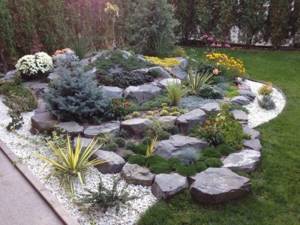
Elements of similar rocks, but of different shapes and sizes, are suitable. Stones whose shape has changed under the influence of wind or water look harmonious. Cobblestones of unusual colors are suitable. They effectively dilute the traditional gray colored cobblestones. In addition to stones, in the construction of an alpine hill, novice landscape designers are advised to use gravel and shards from ceramic dishes. Some people use old kitchen utensils as decoration, for example, leaky buckets or basins.
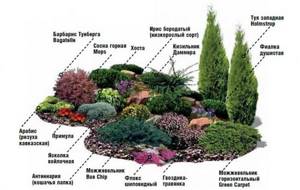
To design a rock garden, plants are selected at the design stage. First, spots of different colors are applied to the diagram. Then plants with a similar shade of foliage or buds are selected. If possible, buy seedlings and seeds of crops belonging to different groups. When creating a rock garden, trees and shrubs of miniature species, perennial herbs and flowering plants are often planted.

Coniferous plants of low-growing species look elegant and solemn:
- dwarf spruce tolerates drought well;
- Thuja is valued for its beautiful crown, which acquires a red tint under the influence of ultraviolet radiation;
- juniper is unpretentious to growing conditions and has a beautiful compact shape;
- Cypress is frost-resistant.
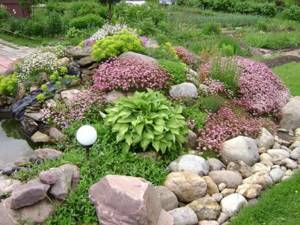
Among deciduous trees, preference is given to species that do not shed their leaves for a long time:
- Iberis looks beautiful from early spring until the onset of frost;
- cotoneaster is distinguished by a dense green crown, which turns red in autumn;
- dryad is a small shrub with large white flowers and fluffy fruits.
Low flowering perennials are suitable for creating a rock garden:
- short-stemmed carnation grows well in a sunny place and blooms profusely;
- rock alyssum retains the green tint of foliage throughout the year;
- juveniles have multi-colored foliage;
- Saxifraga blooms all summer, the buds have different shades.
Bulbous flowers look good in combination with stones. They are planted in small groups. Crocuses, tulips, and hyacinths bloom in early spring. Their flowering makes the hill picturesque immediately after the snow melts. Often, rock gardens are decorated with lingonberries or blueberries. In addition to them, daylilies, bergenia or reeds are planted. The background is filled with herbaceous plants.
Important! Ground cover crops protect slopes from erosion. Therefore, they are planted on the inclined surface of the rock garden.
Rockery and rock garden: similarities and differences
These concepts are often confused even by experienced gardeners. This is not surprising, because they do have many similar characteristics. The basis of rock gardens and rockeries is the use of stones and plants.
A rockery is an ensemble made mainly of stones alone. This is a classic approach to creating a rock garden. Various flowers act only as a background element for the stone rocks.
Rock garden is a man-made hill with stones, planted with flowering plants and small shrubs in the form of tiers. The hill is decorated with Alpine and Carpathian plants, but in the Japanese version Far Eastern species are planted, and in the Mexican version - succulents.
A rockery is a composition of stones, created, as a rule, on a flat relief. It consists of rocks of different sizes, gravel fill and sand. Rare plants are usually the focal point of the entire ensemble. The Japanese rockery can do without plants at all.
A rock garden differs from a rock garden by the obvious unevenness of the relief, because the rock garden is located on a plane. Among its varieties, there are three main style directions:
- Japanese rock garden. It is a composition of stones, where plants play a secondary role and act as color accents. This option will appeal to lovers of peace and harmony.
- A European-style rock garden is as close as possible to the natural landscape.
- The English rockery is distinguished by perennial coniferous shrubs that are so loved by the inhabitants of England
In addition to styles, rockeries can be divided into temporary, permanent and changeable.
A temporary rock garden is organized on a flat or slightly raised area. It is planted with small seedlings that will soon become lush plants. The planting scheme should be drawn up according to the size of adult individuals. Rocks and mounds can be changed as flowers and shrubs grow. The most massive and spectacular boulders are usually reserved for growing plants.
If you don’t plan to pay much attention to the rockery in the future, then the so-called “permanent” rockery will be interesting. Its construction will require large boulders or smaller stones for their grouping. The rock garden is divided into small zones, which are marked with stones. Such zones will help curb excessive plant growth and keep each plant in its place. The slowest growing and easiest to care for will be coniferous plants and low-growing shrubs such as spirea, cinquefoil or barberry.
The changeable rockery is based on planting new plants every year, with the exception of a few large and permanent individuals that will form the basis of the composition. This variety will ensure dynamics and a change of scenery every year.
Choosing stones
The choice of stones directly depends on the design concept of the flower garden project. In the natural environment, stones have chips and uneven surfaces, which creates a unique landscape, for the sake of which we want to recreate it on our site. Therefore, when choosing a stone, it is best to give preference to limestone, shell rock, sandstone, granite and basalt rocks.
Shale rocks have a flat appearance and are well suited for creating terraces, stylized steps and edging flower garden outlines.
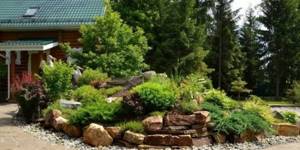
Rounded stones are also often found in rock gardens, but they are more often used to create lawns, borders, and also in structures using artificial reservoirs.

Sometimes it is allowed to use stylized artificial imitations of large blocks of stone. Such specimens can be purchased in specialized stores; they last for quite a long time. Their most important advantage is their absolute resemblance to natural boulders. In some cases, it is indeed more expedient for economic reasons to purchase such an artificial boulder than to look for the possibility of transporting a multi-ton stone specimen to the site.
